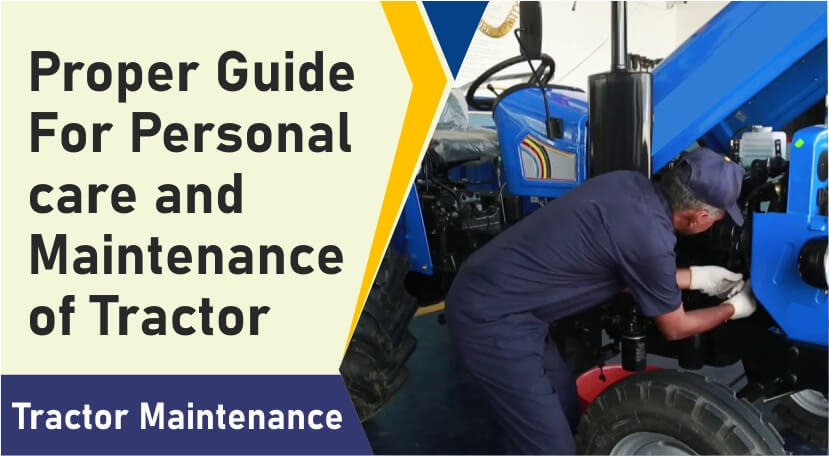Tractors are versatile agricultural equipment with numerous commercial uses. The most important investments you can make to realize all of your agricultural goals are those. Thankfully, banks now provide low-interest loans for farming and tractors with straightforward repayment terms. In recent years, buying a tractor has been simpler. But the real work doesn’t start until after the purchase. You must become almost an expert in tractor maintenance if you want to keep the tractor in good working order.
Tractor maintenance, from regular checks to significant fixes or upgrades. For safe and effective operation, regardless of how reliable the tractor is, you still need to make sure all the parts are in good condition.
Inventory the Tools in Your Tractor
You might avoid needing to enter from the back 40 by using them. Don’t give in to the want to take tools from it. Otherwise, you won’t have that pair of pliers when you need them.
- Pliers, adjustable wrench, and locking pliers
- Screwdrivers: large and small slot and Phillips
- Tire pressure gauge
- Bailing wire
- You need a few pins in each size for your tractor and tools.
- Fuses
- Electrical tape
- Utility knife
- Shear pins and tools to replace them
- Ball-peen hammer
- First aid kit
Making the most of a good harvest requires keeping your tractor in peak condition. You must set up a lot of time and carry out the necessary maintenance procedures each day.
Here are some tractor maintenance suggestions to keep them in good shape:
- Learn from the tractor’s manual:
Each company provides user manuals to customers that provide maintenance advice for their equipment. So, get the owner’s manual and follow the instructions. It contains a maintenance schedule, specifications, fundamental operating instructions, and a list of every component of the apparatus.
- Assemble all of the equipment required for maintenance:
A distinct set of tools are needed for tractor repair than for car maintenance. As a result, make sure you have a wrench and any other tools you’ll need for tractor maintenance, whether you borrow them or buy them.
- Preventing Rain on Your Tractor:
Make sure the seat, instruments, and exhaust system of your tractor are all covered by the weather. Therefore, either keep it covered or store it in a garage.
- Consistently Check Fluids:
The damage could be very costly if the tractor leaks in any way. To find out which parts need to be inspected, consult the owner’s manual. It is necessary to check the transmission fluid, hydraulic oil, battery electrolyte, engine oil, and coolant.
- Ensure that your tyres are properly inflated:
Not all tractors require the same inflation pressure. The pressures required for the front and rear tyres of a tractor may differ. Check the air pressure frequently as a result.
- Pay Attention To The Brakes:
Almost all tractors come with automatic brakes. Now all you have to do is make sure your brake system is working and maintained correctly. If your brake system is not functioning properly, you must have it fixed or replaced right away.
- Evaluate Filters:
The system might become contaminated and have components fail due to dirt and dust. In order to shield the system from damaging contaminants, tractors feature filters. Regularly inspecting the fuel and air filters is an excellent idea. Replace it if it cannot be cleaned to an acceptable standard.
- Lubricate Often:
To operate effectively, the tractor must be adequately oiled. Use heavy-duty lubricants, and check the oil level frequently. The use of oils made for cars and other light vehicles should be avoided. Check the tractor for any moving parts and clean and grease them.
- Don’t Stuff The Tractor Too Full:
It’s essential to use an attachment that is the right size for the task you are performing. Make sure your tractor isn’t overburdened to prevent premature wear and tear.
- Refuel the vehicle’s fuel tank
If the tank still contains fuel that was previously stored there for the winter, remove it and replace it with new gasoline. This reduces the possibility of condensation accumulation in the engine, resulting in smoother operation. It’s a good idea to check the other fluid levels while you’re examining the gasoline quality. If additional coolant or engine or hydraulic oil is required, do so immediately. These fluids are crucial for maintaining the transmission’s lubrication, lowering the amount of moisture, and preventing the engine from overheating.
- Examine the belts for cracks.
Given that the tractor depends on its drive belts to power all internal operations, it is essential that they are in good working order to ensure the tractor’s optimum longevity. The alternator, hydraulic pumps, battery charge, cutting blades, and other components are also impacted when the belts are faulty. In order to determine whether new belts are required, check the belts for weather abrasion, rotting, slipping, and malfunction. This can typically be done manually. However, if they’re in really bad form, you might need help from an expert.
Side note: Perform a Daily Inspection
You may avoid hours of frustration and possibly thousands of dollars in repairs by taking a few extra minutes each day. Each day before you climb on your tractor, check these items.
- Fuel: Start the engine and then check the fuel gauge.
- Oil: Verify that the oil level is within the acceptable range using the dipstick. If more than a half-quart low, top off.
- Coolant: Check the coolant level and, if necessary, top it out with the recommended coolant.
- Radiator: Clear the radiator of any debris that can obstruct airflow.
- Tyre: All tyre pressure should be checked. Low-pressure front tyres might appear to be in good condition, but when a front-end loader is used to lift a big load, they risk being damaged or coming off the rim.
- ROPS/Seatbelt: Verify that the roll bar is raised and fastened.
- Lights: Check the lights if you plan to use them.
- Pins and Connectors: Ensure that all of the pins and connectors are properly positioned and fastened.
- Hydraulic lines: Check the hydraulic lines for damage or cracks.
- Oil/Fuel leaks: Leaks of oil or fuel should be checked for under the tractor.
- Communication Tools: Make sure your communication tools, including your cell phone and radio, are functional and charged.
To get the latest updates on the tractor, tractor price, and tractor news install the KhetiGaadi application.




